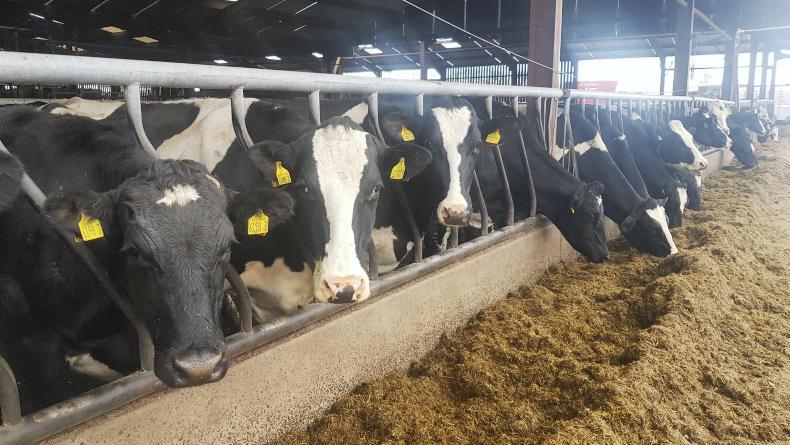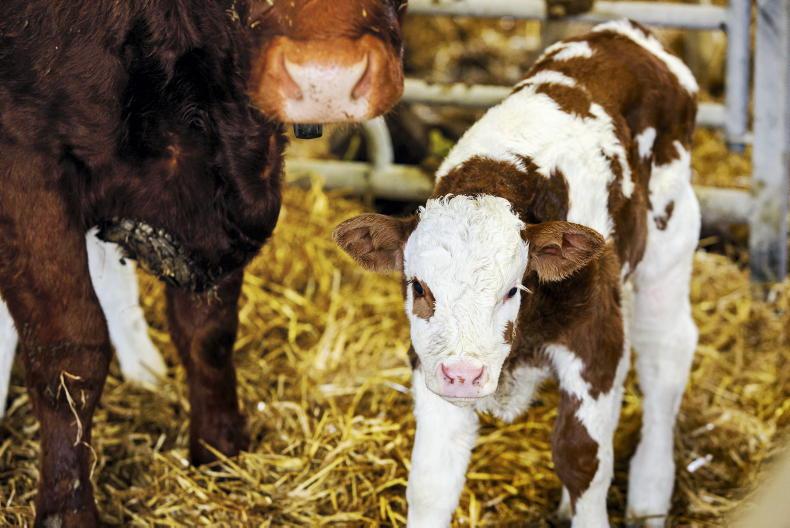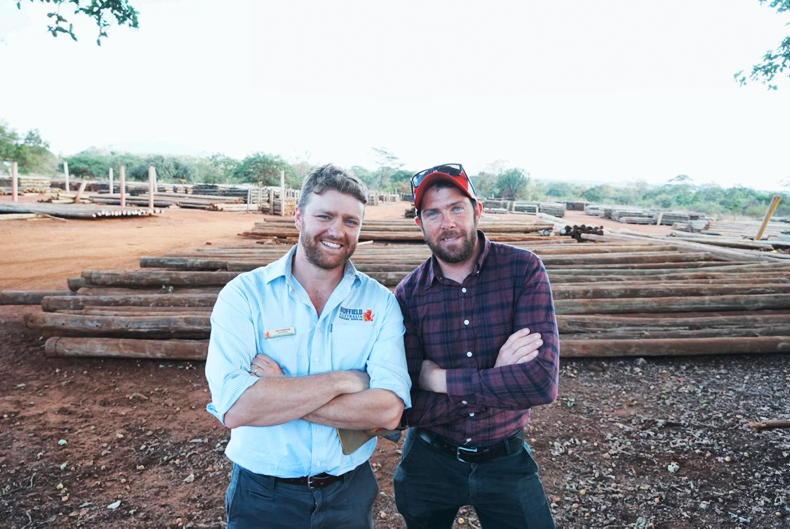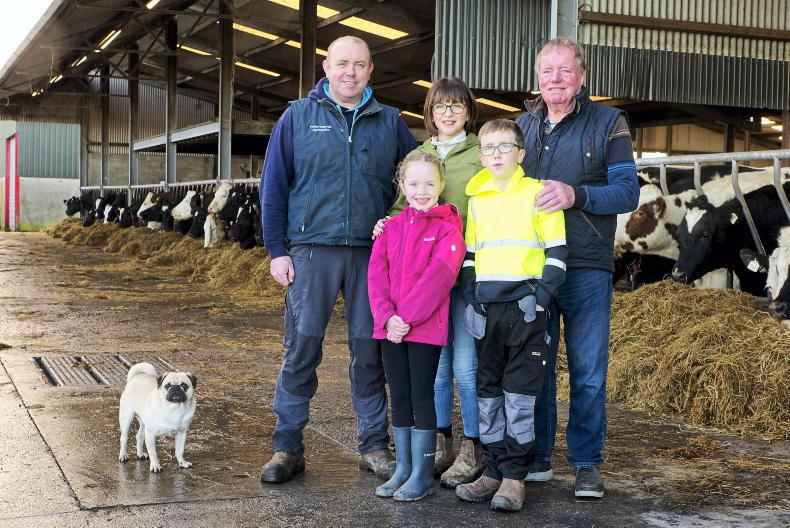Producing as much milk as possible from good-quality silage and grazed grass is a key focus for autumn-calving farmers on the Dairylink Ireland programme.
The latest benchmarking figures from phase one participant Bill Brown show that he is continuing to make strides at producing more milk from forage.
Dairylink: Driving milk from forage in Down.
Milk from forage is calculated by dividing total concentrate fed per cow by 0.45, and then subtracting the answer from total milk yield per cow.
Bill was revisited last week as part of a twice-yearly review of phase one farmers. His latest 12-month rolling average figure for milk from forage stands at 3,715 litres. This is based on cows averaging 7,768 litres from 1.97t of concentrate.
Milk from forage on the Brown farm has risen by over 1,000 litres since the start of the first phase of Dairylink in 2015.
Bill has been particularly focused on getting cows out to grass early in the spring by investing in grazing infrastructure and having cows calve down early in the autumn.
The latter allows more cows to be suitable candidates for early grazing, as most are past peak lactation and settled in-calf by February.
Although some changes on farms had an almost immediate impact, most of the steps that were implemented during the first phase of Dairylink had longer term results.
The main example on the Brown farm is steps taken to increase milk components. Holstein sires were selected for transmitting ability for fat and protein, and some Jersey and Kiwi-Cross genetics were also introduced to boost milk solids.
More cows with these genetics are milking each year and the results are now being seen. The latest monthly benchmarking figures had fat and protein averages at 4.22% and 3.79% during September, up from 4.15% and 3.60% respectively in the same month last year.
Weekly round-up
Participants from phase one of Dairylink Ireland are still seeing results from steps that were taken several years ago.Calving is continuing on programme farms that have autumn-calving cows.Breeding will start on these farms within the next two weeks.Heat detection is taking place ahead of breeding on most farms.Farmer focus: Bill Brown, Millisle, Co Down
Calving is over 70% complete on Bill Brown’s farm at the top of the Ards Pensuila in Co Down. The autumn-calving herd has 140 early-lactation cows going through the parlour at present and there are 55 left to calve down.
Bill has developed a fairly compact autumn-calving profile in recent years. There had been 62 calvings by the end of September and only 13 cows are due in the new year.
There are 68 replacement heifer calves on the ground on the Brown farm and only beef-sired calves will be dropping from now on.
This group of heifers were born within a two-month period and it is a further improvement on the 47 heifers that were born within a three-and-a-half-month period last year.
The small age range in 2019-born replacements will mean the group will be uniform and easy to manage, as well as eligible for serving (and due for calving) at the same time.
Also, these heifers were bred from either first-calvers that have the highest genetic potential in the herd or older cows that were fertile and quick to get back in-calf.
On target
The 2018-born replacements on the Brown farm will be ready for service at the end of November.
“We weighed them around a month ago and the 47 heifers averaged 360kg. There were only six heifers below 320kg, so we didn’t have to pull out a group of under-performers for early housing or special treatment,” Bill said.
All maiden heifers were housed two weeks ago to give them time to settle and transition on to their winter diet before breeding.
Bill is considering synchronising heifers with CIDRs this year and using fixed-time AI, as it will have a lower labour requirement than detecting heats and serving heifers over several weeks.
Bill has selected high-EBI sires with a focus on fertility sub-index and transmitting ability for fat and protein. For example, sexed semen from Killwalsh Andrew will be used predominantly in the maiden heifers. Andrew has an overall EBI index of €302, fertility SI of €145, 0.17% fat and 0.17% protein.
Other sires in the flask include Ballymaw Nova (EBI €275), Hillary Samson (EBI €270) and Westcoast VH Praser (EBI €224).
Labour efficiency
Calf accommodation has been renovated on the Brown farm to improve labour efficiency for calf rearing.
“The tighter calving block means we have a glut of calves coming early in the autumn, so we need to have handy facilities,” Bill said.
An existing shed with automatic calf feeders contains 40 dairy-sired heifers at present.
The remaining heifer calves are in new accommodation, along with any dairy-sired bulls and beef-bred calves that haven’t been sold yet.
The new accommodation is under the same roof as calving pens and includes individual calf pens, as well as group pens which hold up to 12 calves each. Bill has a portable milk cart with electronic pump for mixing and feeding out milk replacer in teat feeders.
Read more
Dairylink: welcome rain greens up Co Down
Watch: reducing concentrate feeding in Down
Calf rearing in full swing in Co Down
Producing as much milk as possible from good-quality silage and grazed grass is a key focus for autumn-calving farmers on the Dairylink Ireland programme.
The latest benchmarking figures from phase one participant Bill Brown show that he is continuing to make strides at producing more milk from forage.
Dairylink: Driving milk from forage in Down.
Milk from forage is calculated by dividing total concentrate fed per cow by 0.45, and then subtracting the answer from total milk yield per cow.
Bill was revisited last week as part of a twice-yearly review of phase one farmers. His latest 12-month rolling average figure for milk from forage stands at 3,715 litres. This is based on cows averaging 7,768 litres from 1.97t of concentrate.
Milk from forage on the Brown farm has risen by over 1,000 litres since the start of the first phase of Dairylink in 2015.
Bill has been particularly focused on getting cows out to grass early in the spring by investing in grazing infrastructure and having cows calve down early in the autumn.
The latter allows more cows to be suitable candidates for early grazing, as most are past peak lactation and settled in-calf by February.
Although some changes on farms had an almost immediate impact, most of the steps that were implemented during the first phase of Dairylink had longer term results.
The main example on the Brown farm is steps taken to increase milk components. Holstein sires were selected for transmitting ability for fat and protein, and some Jersey and Kiwi-Cross genetics were also introduced to boost milk solids.
More cows with these genetics are milking each year and the results are now being seen. The latest monthly benchmarking figures had fat and protein averages at 4.22% and 3.79% during September, up from 4.15% and 3.60% respectively in the same month last year.
Weekly round-up
Participants from phase one of Dairylink Ireland are still seeing results from steps that were taken several years ago.Calving is continuing on programme farms that have autumn-calving cows.Breeding will start on these farms within the next two weeks.Heat detection is taking place ahead of breeding on most farms.Farmer focus: Bill Brown, Millisle, Co Down
Calving is over 70% complete on Bill Brown’s farm at the top of the Ards Pensuila in Co Down. The autumn-calving herd has 140 early-lactation cows going through the parlour at present and there are 55 left to calve down.
Bill has developed a fairly compact autumn-calving profile in recent years. There had been 62 calvings by the end of September and only 13 cows are due in the new year.
There are 68 replacement heifer calves on the ground on the Brown farm and only beef-sired calves will be dropping from now on.
This group of heifers were born within a two-month period and it is a further improvement on the 47 heifers that were born within a three-and-a-half-month period last year.
The small age range in 2019-born replacements will mean the group will be uniform and easy to manage, as well as eligible for serving (and due for calving) at the same time.
Also, these heifers were bred from either first-calvers that have the highest genetic potential in the herd or older cows that were fertile and quick to get back in-calf.
On target
The 2018-born replacements on the Brown farm will be ready for service at the end of November.
“We weighed them around a month ago and the 47 heifers averaged 360kg. There were only six heifers below 320kg, so we didn’t have to pull out a group of under-performers for early housing or special treatment,” Bill said.
All maiden heifers were housed two weeks ago to give them time to settle and transition on to their winter diet before breeding.
Bill is considering synchronising heifers with CIDRs this year and using fixed-time AI, as it will have a lower labour requirement than detecting heats and serving heifers over several weeks.
Bill has selected high-EBI sires with a focus on fertility sub-index and transmitting ability for fat and protein. For example, sexed semen from Killwalsh Andrew will be used predominantly in the maiden heifers. Andrew has an overall EBI index of €302, fertility SI of €145, 0.17% fat and 0.17% protein.
Other sires in the flask include Ballymaw Nova (EBI €275), Hillary Samson (EBI €270) and Westcoast VH Praser (EBI €224).
Labour efficiency
Calf accommodation has been renovated on the Brown farm to improve labour efficiency for calf rearing.
“The tighter calving block means we have a glut of calves coming early in the autumn, so we need to have handy facilities,” Bill said.
An existing shed with automatic calf feeders contains 40 dairy-sired heifers at present.
The remaining heifer calves are in new accommodation, along with any dairy-sired bulls and beef-bred calves that haven’t been sold yet.
The new accommodation is under the same roof as calving pens and includes individual calf pens, as well as group pens which hold up to 12 calves each. Bill has a portable milk cart with electronic pump for mixing and feeding out milk replacer in teat feeders.
Read more
Dairylink: welcome rain greens up Co Down
Watch: reducing concentrate feeding in Down
Calf rearing in full swing in Co Down









SHARING OPTIONS